Dutch 17th century still lifes represent a felicitous confluence of artistic talent, religious freedom, societal support, disposable income, and plentiful subject matter. The apparently static, but faithfully depicted, arrangements of objects express a startling range of themes and messages. They reflect the cultural, economic, and scientific achievements of their time, as well as its foibles1, with equal fidelity (Jaeger). Jan Davidzoon de Heem’s mid-17th century example of this genre, Banquet Still Life with a View onto a Landscape fits superbly into the still life tradition without pedanticism or predictability2. It is appreciable as visual treat, moral lesson, and précis of the times.
Painted in roughly 1645, Banquet presents the viewer with a lush and vivid array of foodstuffs, textiles, metalwork, glass, and the bonus of a small background landscape as well. The painting, in oil on wood panel, is modest in size3, and thus the subjects are slightly less than life-size.
The painting depicts fruits of the orchard ocean, in a lavish plentitude. They cover a heavily carved wooden table. The table covering, of green silk velvet textile, rumples underneath the display.
The fruits and nuts, and what appears to be pear leaves, are heaped on, and off, an elaborate silver pedestal dish. Accompanying them are grape leaves, trailing from a partially filled, decorated, conical goblet of colored glass, presumably for wine. On the table, spilling from a worked metal platter4, are depicted at least three varieties of seafood, both whole and opened for consumption. Cherries, probably sour5, rest among their leaves.
Behind the display hangs a generously fringed rug in olive tones. Pulled back to one side, by the ornate tassel, hangs another textile in a shade of burgundy. This reveals a wooded landscape, lake, and yet more distant blue mountains.
A knife rests on the platter’s edge, its blade buried in the partial peelings of a large citrus fruit. The handle is geometrically worked in blue-black and mother-of-pearl.
The setting is indeterminately fanciful. One could, however, imagine this table laid on an outdoor porch. The curtaining might prevent draft from the gracious valley below.
The texture is nearly invisible, as one would expect from that era. The painting overall, looks in good shape for being from the 1600s.
While the primary axis of the painting is largely horizontal, two large triangles dominate the composition. One triangle is formed by the large red textile’s folded edge, and the differentially highlighted area of the olive toned rug. The other triangle legs comprise the pedestal compote and piled-up fruits, on one side, and the leaves on the other.
Typical of its era, de Heem’s line is precise, relatively sharp, and does not obtrude. The texture aims for loving fidelity. The surfaces, whether the dimpled citrus skin, the velvet pile, the contrast between the crisp leaves and almost translucent cherries, are plausibly rendered with near-invisible brush strokes. This is an advance from de Heem’s earlier works, such as his Still Life, signed and dated 1626, which has been criticized for the “glassy” look of his grapes (Meijer).
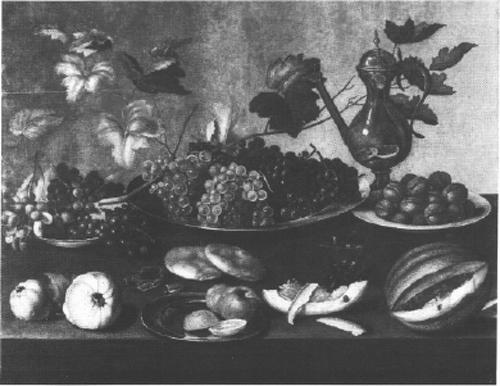
Within Banquet’s relatively shallow volume, de Heem manages to achieve a remarkable sense of perspective. He does this by diagonally angling the velvet table-cover’s wrinkles, and highlighting and shading the fruits. In another signal of depth, he layers his subjects from front to back: crabs, shrimps and giant oysters, then stone fruits, then, at the rear of the space, peeking out from under the silver pedestal bowl, large red grapes.
The objects include a range of sizes and densities. There are thin leaf edges, huge citruses, and the weighty table. All are believably resting on credible surfaces.
The warm palette picks up the peach and apricot tones, even the seafood. These contrast strongly with the greens of the rug and tablecloth and the burgundy hanging.
As a still life painted in Utrecht, in the mid-1600s, this represents one of the indulgences of a newly liberated wealthy class. Europe, and especially the Netherlands, was enjoying a period of opportunity and widening horizons. Art reflected this reality.
In the Low Countries especially, as a haven for the Protestant Reformation, art was freed from obligate tie to liturgical subject matter6. Still lifes, although unconstrained by religion, nonetheless often conveyed deeply moral messages.
As examples, De Heem depicts the fruits’ imminent decay realistically. In the tradition of Dutch still lifes, this dissolution reminds viewers of the temporary nature of the patron’s proud, but mortal achievements. It also presages corporeal death, and the need for an observant Christian to ensure their soul’s health. The peeled citrus may refer to the unwinding of time and the inevitable disappearance of all earthly things. The subtle messages are readily ignored.
This contrasts with the explicit, even blatant messages in other works. Note the possible allusion to the ‘book of life’7 in the Vanitas of Jan van der Heyden, pictured here. The globe, while celebrating recent discoveries around the world, may also invoke God’s power as author of all things.
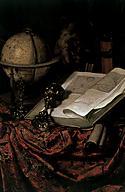
De Heem himself was more explicit in his other still lifes, for example, Bouquet in a Glass Vase. This shows flowers, fruits and grains not ordinarily in bloom simultaneously8. This suggests a metaphor for the inevitable cycle of life.
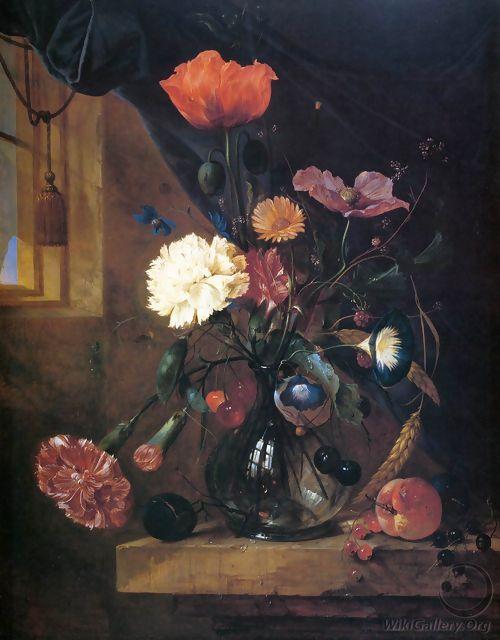
Dutch still lifes also frequently reflected the discovery and colonization of other continents, and trade with still more locales. The oranges and lemons, native to southern climes, may fulfill this function. Banquet’s harmonious arrangement does not apparently include overt references to the Netherlands’ Pacific adventures, unlike many works by de Heem’s inspiration, the earlier artist Balthazar van der Ast. The exotic seashells in van der Ast’s paintings all seem to bespeak a South Seas origin9, rather than a pedestrian northern beach.
A source for de Heem’s trompe l’oeuil ‘opening up’ of the composition’s rear to a landscape is also visible in Balthazar van der Ast’s work and Ambrosius Bosschaert’s work. Consider Ast’s Still Life with Flowers, Fruit, and Shells and Bosschaert’s Bouquet of Flowers in a Window Niche10. These ‘views’ add visual and symbolic interest. In de Heem’s Banquet, it refers perhaps to the next life, to the patron’s unbounded horizons for achievement, or possibly simply to the landscape around their property.
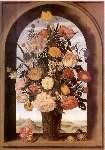
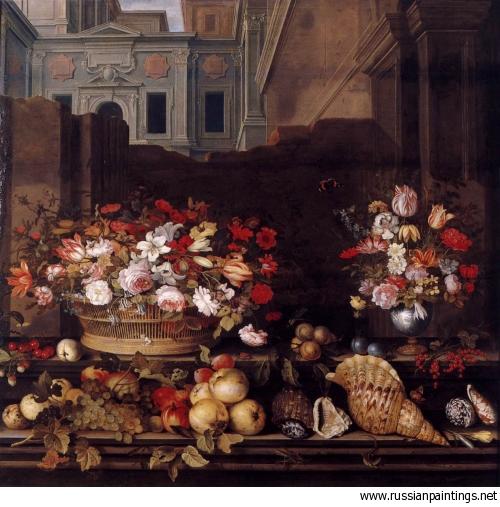
De Heem’s Banquet amply showcases the secular success of his patron. The white-fleshed peaches, apricots,11 and oranges12 represent evanescently seasonal treats. The seafood bespeaks expensive transport13. The thin delicate glass for drinking, rather than pewter or simple ceramic, points to wealth and ease. The much abused luxurious textiles covered with messy foods are clear conspicuous consumption.
These all compliment the financial success of the eventual owner. This disposable income was generated by trade, by banking sophistication, and by scientific and engineering advancements. Increased productivity resulted in greater profits.
The Banquet Still Life with a View onto a Landscape is relatively restrained and chaste in comparison to another work reliably attributed to him, his Still Life with Parrots (late 1640s), which explodes with exoticism in the brilliant bird, spooky black-toned leaves, giant shells, and oriental-looking hookah (or whatever it is!) (Southgate) (de Heem, Still Life with Parrots).
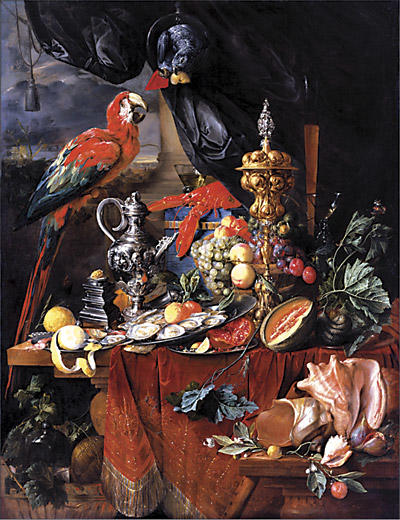
Banquet’s play of light off brass, silver, and colored glass reveals his apparent lifelong obsession with capturing reflections on glossy surfaces. This was a technique demonstrated beautifully by his inspiration, Balthazar Van Der Ast, in previous decades (Meijer). It was a tour de force of light effects.
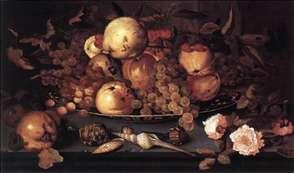
In addition to van der Ast, other influences ‘in the air’ contemporaneously in Europe included artists such as Fede Galizia, a pioneer of the still life (Galizia)14. Galizia’s work, such as Peaches in a Pierced White Faience Basket is spare by comparison (Spike), and confined in a shallower, smaller, more dramatically shadowy space. However, her uncanny accuracy, which may reflect her familiarity with Caravaggio’s work15, such as his Still Life, seems a clear precursor to De Heem.
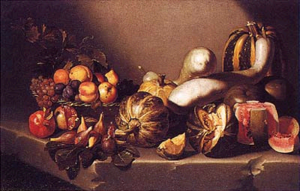
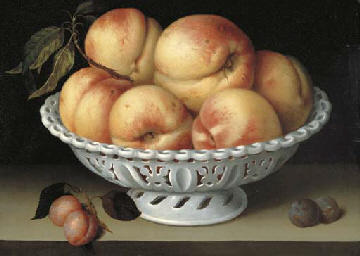
His contemporary compatriot, Floris van Dijk, suggests more narrative into his work. In Still Life with Cheese, emerging from shadow are senescing Goudas, dramatically overturned glassware, knife, precarious plate, and sacramentally broken bread on complexly jacquarded table-covering. These remind the viewer of Christ, human mortality and fallibility, and simultaneous telegraph wealth.
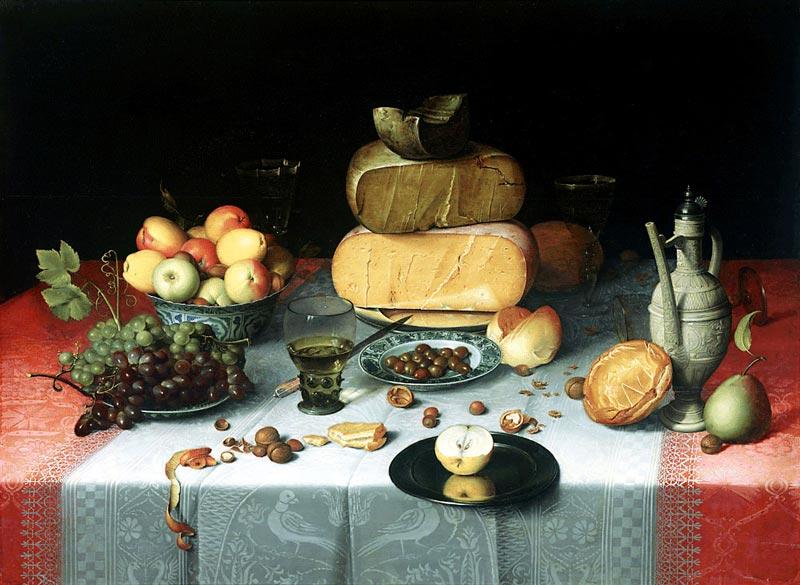
The impact of de Heem’s lapidary works is attested in contemporaries such as Walscappelle (Royo-Villanova) (Sotheby’s) , and seen centuries later in the precision of Henri Fanton-Latour’s Still Life: Corner of a Table. While bearing the clear influence of photography in its off-center, candid composition, this harkens back to de Heem and his co-evals in treasuring small quotidian objects, both natural and man-made.
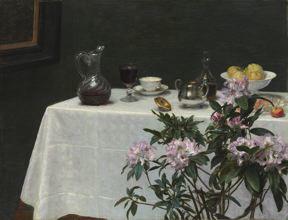
In conclusion, Banquet is meaningful on several levels, but also exquisite viewed merely as decoration. The painting fits into the Dutch, and wider European tradition, of still lifes. The symbolism is nearly endless, given the variety of fruits and objects in the picture. De Heem’s facile technique reminds a modern viewer of super-realism. Whether as warning against worldly over-confidence, or as a magnificent representation of the riches the earth and sea, it is glorious to look at, and influential then and centuries later.
Bibliography
2artgallery. “Still Life with a Dish of Fruit: Balthazar van der Ast.” 2006. Web.
Caravaggio. Still Life With Fruit. Denver Art Museum, Denver. Web.
Dardel. “Still Life with Cheese: Van Dijk.” 2011. Dardel. Web.
de Heem, Jan Davidzoon. “Jan Davidzoon de Heem: Bouquet in a Glass Vase.” 2011. Web.
“Still Life with Parrots.” Viewer. Web.
Duerer Home Page. “Ambrosius Bosschaert the Elder.” 2011. Duerer Home Page. Web.
Galizia, Fede. “Women Artists: Fede Galizia.” 2011. Web.
Grove Art. “Jan Davidzoon de Heem.” 2011. Oxford Art Online. Web.
Heyden, van der. Vanitas. Akademie der Bildenden Künste. Scholarsresource. Vienna, 1637-1712. Web.
Jaeger, William. “Albany Institute of….” (n.d.). Web.
Labedzki, Annette. “Fede Galizia.” 2011. Ezine.
Louvre. “Flowers and shells of Balthazar van der Ast (1593/94-1657):Defense and illustration of the painting of Dutch flowers in the Louvre.” The Review of the Louvre and Musees de France 51.NO3 15-18 I (2001): 15-18 I. Web.
Meijer, Fred G. “Jan Davidsz. de Heem’s Earliest Paintings, 1626-1628.” 2011. Kunstpedia. Web.
Pioch, Nicolas. What is the Tres Riches Heures? 2002. Web.
Royo-Villanova, Mercedes. “Bodegones holandeses inéditos del Museo Lázaro Galdiano.” Goya: Revista de arte Nº 289-290 (2002): 217-226. Web.
Sotheby’s. “Important Old Master Paintings & Sculpture: Lot 145 – JACOB VAN WALSCAPELLE – DORDRECHT 1644 – 1727 AMSTERDAM – A GARLAND OF FLOWERS AND FRUIT BOUND TOGETHER AT THE ENDS WITH BLUE RIBBON AND HANGING FROM TWO NAILS.” 2011. Sotheby’s. Web.
Southgate, M. Therese. “Still Life With Parrots.” 2008. JAMA. Web.
Spike, John. “Peaches in a pierced white faience basket.” 2006. Christies. Web.
Terminartors. “Balthasar van der Ast: Still Life with Flowers Fruit and Shells.” 2011. Terminartors. Web.
The Art Institute of Chicago. “Overview: Latour’s Still Life: Corner of a Table.” 2005. Art Explorer. Web.
Footnotes
- The Dutch loved pictures of breakfast or any meal! (Jaeger).
- The still life, as a genre, had experienced a revival from its efflorescence in Classical times, as was the case with so many art techniques of the Renaissance and subsequent decades.
- It is about one and three quarter feet by a bit less than two and a half feet (54 centimeters by 74 centimeters).
- It appears to be either brass or silver.
- This inference is based on the light red color and near translucency.
- In the pre-Reformation period, virtually all art depicted religious subjects, with rare exceptions, such as Les Tres Riches Heures du Duc de Berry (Pioch). Even this, upon closer examination, turns out to be the illustrations for a daily prayer book.
- This familiar image, drawn from both Old Testament sources (e.g., Ezekiel), and New Testament references (e.g., Revelations), is the record of all people, and their good and bad deeds upon which the Last Judgment would be based.
- The wheat would be a late summer crop, the sweet peas ripen almost before summer starts, and the cherries are from the height of summer, as are the poppies and carnations.
- These shells have been identified more specifically as, “proven ant de deux régions tropicales… domaine des Cara”ibes, {et}… l’Indo-Pacifique.” (Louvre).
- De Heem’s architectural details are said to show the influence of interiors by Rembrandt and Jan Lievens (Grove Art).
- This assertion is based on the current resource-intensiveness of their cultivation, the briefness of their season in the Northern Hemisphere, and the challenges of transporting them without damage; resulting in astronomical prices per pound.
- The citrus might have even required an orangerie to grow in the cold of the Netherlands.
- Seafood, while readily available to residents of the coast, would have required well built and maintained roads to transport anywhere more than a few hours by horse cart from the ocean.
- As she was a resident of Milan, it is not clear whether de Heem saw her work. As a woman, she was under-appreciated for her still lifes, a genre wherein she innovated (Spike), and her work sometimes mis-attributed (Labedzki). The still-life was an acceptable outlet for a female when others were not available.
- They were both Italians, and the elder Caravaggio’s influence on Galiazi has been attested (Spike).